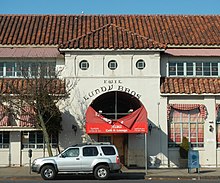
Union Square is a historic intersection and surrounding neighborhood in Manhattan, New York City, United States, located where Broadway and the former Bowery Road – now Fourth Avenue – came together in the early 19th century. Its name denotes that "here was the union of the two principal thoroughfares of the island". The current Union Square Park is bounded by 14th Street on the south, 17th Street on the north, and Union Square West and Union Square East to the west and east respectively. 17th Street links together Broadway and Park Avenue South on the north end of the park, while Union Square East connects Park Avenue South to Fourth Avenue and the continuation of Broadway on the park's south side. The park is maintained by the New York City Department of Parks and Recreation.

Sheepshead Bay is a neighborhood in southern Brooklyn, New York City. It is bounded by Ocean Parkway to the west; Avenue T and Kings Highway to the north; Nostrand Avenue and Gerritsen Avenue to the east; and the Atlantic Ocean to the south. Sheepshead Bay is abutted by the neighborhoods of Brighton Beach and Homecrest to the west; Midwood to the north; and Gerritsen Beach to the east.

The Borough Hall/Court Street station is an underground New York City Subway station complex in Brooklyn shared by the BMT Fourth Avenue Line, the IRT Broadway–Seventh Avenue Line and the IRT Eastern Parkway Line. The complex comprises three stations: Borough Hall on the IRT lines and Court Street on the BMT line. The stations are located under Court, Joralemon, and Montague Streets, next to Brooklyn Borough Hall, in the Downtown Brooklyn and Brooklyn Heights neighborhoods of Brooklyn. It is served by the 2, 4, and R trains at all times; the 3 train all times except late nights; the 5 train on weekdays; the N train during late nights; and limited rush-hour W trains.
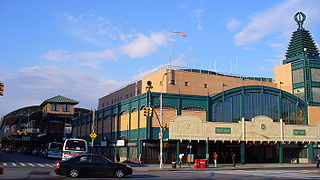
The Coney Island–Stillwell Avenue station is a New York City Subway terminal in Coney Island, Brooklyn. It is the railroad-south terminus for the D, F, N, and Q trains at all times and for the <F> train during rush hours in the peak direction.
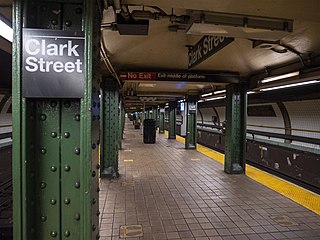
The Clark Street station is a station on the IRT Broadway–Seventh Avenue Line of the New York City Subway. It is located at Clark Street and Henry Street in Brooklyn Heights, Brooklyn. It is served by the 2 train at all times and the 3 train at all times except late nights. At approximately 80 feet (24 m) deep, the Clark Street station contains one island platform and two tracks. Its only exit is via a set of three elevators, which lead from a passageway above the platform to the ground story of the Hotel St. George. Despite being one of three New York City Subway stations that can only be accessed by elevators, the Clark Street station is not wheelchair-accessible with only stairs leading to the platforms.

1 Wall Street is a mostly residential skyscraper in the Financial District of Lower Manhattan, New York City, on the eastern side of Broadway between Wall Street and Exchange Place. 1 Wall Street, designed in the Art Deco style, is 654 feet (199 m) tall and consists of two sections. The original 50-story building was designed by Ralph Thomas Walker of the firm Voorhees, Gmelin and Walker and constructed between 1929 and 1931, while a 36-story annex to the south was designed by successor firm Voorhees, Walker Smith Smith & Haines and built between 1963 and 1965.

Tudor City is an apartment complex on the East Side of Manhattan in New York City, bordering the Turtle Bay and Murray Hill neighborhoods. Designed and developed by the Fred F. French Company, it lies on a low cliff east of Second Avenue, between 40th and 43rd Streets, and overlooks First Avenue to the east. Construction commenced in 1926, making it the first residential skyscraper complex in the world. Tudor City was one of the first and largest examples of a planned middle-class residential community in New York City. Named for its Tudor Revival architecture, the complex is a New York City designated landmark district and is listed on the National Register of Historic Places.

Ocean Parkway is a 4.86-mile (7.82 km) boulevard in the west-central portion of the New York City borough of Brooklyn. It is inventoried by the New York State Department of Transportation (NYSDOT) as New York State Route 908H (NY 908H), an unsigned reference route.

The Atlantic Avenue–Barclays Center station is a New York City Subway station complex shared by the BMT Fourth Avenue Line, the BMT Brighton Line and the IRT Eastern Parkway Line. Named after Atlantic Avenue and the Barclays Center arena, it is located at Fourth and Flatbush Avenues' intersections with Atlantic Avenue and Pacific Street in Downtown Brooklyn. The complex is served by the 2, 4, D, N, Q and R trains at all times; the 3 train at all times except late nights; the 5 and B trains on weekdays during the day; and a few rush-hour W trains.

Gage and Tollner is an American cuisine restaurant on 372–374 Fulton Street in the Downtown Brooklyn neighborhood of New York City. The restaurant is named for its initial proprietors, Charles Gage and Eugene Tollner. It is located on the lowest two stories of a converted four-story brownstone residence that was built in the mid-1870s. The restaurant building is listed on the National Register of Historic Places, and its facade and interior are New York City designated landmarks. As of 2021, the restaurant is operated by St. John Frizell, Sohui Kim, and Ben Schneider.
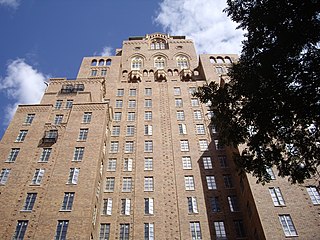
Barbizon 63 is a mostly residential condominium building at 140 East 63rd Street, at the southeast corner with Lexington Avenue, on the Upper East Side of Manhattan in New York City. The 23-story hotel was designed by Everett F. Murgatroyd and Palmer H. Ogden in a blend of the Italian Renaissance, Late Gothic Revival, and Islamic styles. From 1927 until 1981, it was a women-only residential hotel. The Barbizon is listed on the National Register of Historic Places and is a New York City designated landmark.
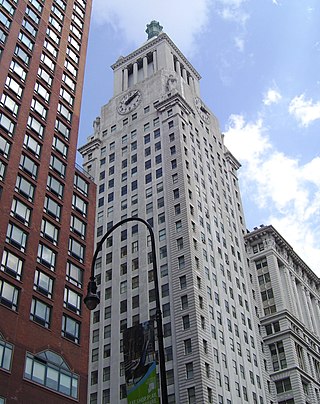
The Consolidated Edison Building is a neoclassical skyscraper in the Gramercy neighborhood of Manhattan in New York City, United States. The 26-story building was designed by the architectural firms of Warren and Wetmore and Henry Janeway Hardenbergh. The building takes up the western two-thirds of the block bounded by 14th Street to the south, Irving Place to the west, 15th Street to the north, and Third Avenue to the east. It serves as the headquarters of energy company Consolidated Edison, also known as Con Ed.

The Austin, Nichols and Company Warehouse, also known as 184 Kent Avenue and Austin Nichols House, is a historic warehouse building on the East River between North 3rd and North 4th Streets in Williamsburg, Brooklyn, New York City. The structure, measuring 179 by 440 feet, was built in the Egyptian Revival style; it is one of the city's few buildings in that style. The building was designed by architect Cass Gilbert and erected by general contractor Turner Construction with the help of structural engineer Gunvald Aus.

The 14th Regiment Armory, also known as the Eighth Avenue Armory and the Park Slope Armory, is a historic National Guard armory building located on Eighth Avenue between 14th and 15th Streets in the South Slope neighborhood of Brooklyn, New York City, United States. The building is a brick and stone castle-like structure, and designed to be reminiscent of medieval military structures in Europe. It was built in 1891–95 and was designed in the Late Victorian style by William A. Mundell.
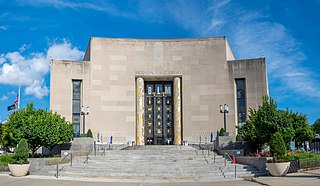
The Central Library, originally the Ingersoll Memorial Library, is the main branch of the Brooklyn Public Library in Brooklyn, New York City. Located on Grand Army Plaza, at the corner of Flatbush Avenue and Eastern Parkway, it contains over 1.7 million materials in its collection and has a million annual visitors. The current structure was designed by the partnership of Alfred Morton Githens and Francis Keally in the Art Deco style, replacing a never-completed Beaux-Arts structure designed by Raymond Almirall. The building is a New York City designated landmark and is listed on the National Register of Historic Places.
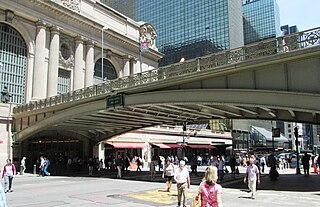

The Brooklyn Tower is a supertall mixed-use, primarily residential skyscraper in the Downtown Brooklyn neighborhood of Brooklyn in New York City. Developed by JDS Development Group, it is situated on the north side of DeKalb Avenue near Flatbush Avenue. The main portion of the skyscraper is a 93-story, 1,073-foot (327 m) residential structure designed by SHoP Architects. Preserved at the skyscraper's base is the Dime Savings Bank Building, designed by Mowbray and Uffinger, which dates to the 1900s.

The Shore Theater is a former theater in Coney Island, Brooklyn, New York City. The seven-story neo-Renaissance Revival building, with office space as well as a theater, is located at the intersection of Surf and Stillwell Avenues, across from Nathan's Famous and the Coney Island–Stillwell Avenue station. Completed in 1925, it was one of several structures that was intended to boost the development of Coney Island as a year-round entertainment destination. After being abandoned in the 1970s, it stood unused for several years before being redeveloped into a hotel in the late 2010s; however, as of 2022, the building is still closed and undergoing construction.
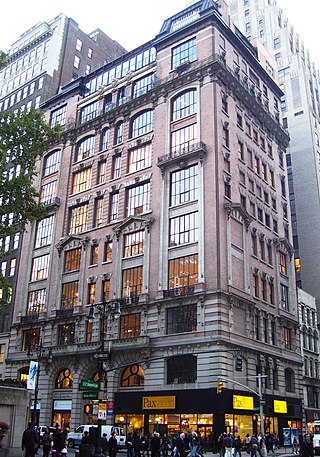
The Bryant Park Studios is an office building at 80 West 40th Street in the Midtown Manhattan neighborhood of New York City, at the corner of 40th Street and Sixth Avenue. The building, overlooking the southwest corner of Bryant Park, was designed by Charles A. Rich in the French Beaux-Arts style. Built from 1900 to 1901 by Abraham A. Anderson, the building is one of several in Manhattan that were built in the early 20th century as both studios and residences for artists.

4 Park Avenue is a 22-story building in the Murray Hill neighborhood of Manhattan in New York City. Designed by Warren and Wetmore, the structure was built for Alfred Gwynne Vanderbilt and opened in 1912 as a hotel. It is along the west side of Park Avenue between 33rd and 34th Streets. Following a renovation by Schuman, Lichtenstein & Claman between 1965 and 1967, the top 18 stories have been used as residential apartments. The lowest three stories above ground, as well as three basement levels, are used as commercial space and carry an alternate address of 6 Park Avenue. As of 2021, the building is owned by The Feil Organization.






